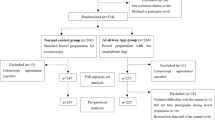Abstract
Background
The stool color card has been the primary tool for identifying acholic stools in infants with biliary atresia (BA), in several countries. However, BA stools are not always acholic, as obliteration of the bile duct occurs gradually. This study aims to introduce Baby Poop (Baby unchi in Japanese), a free iPhone application, employing a detection algorithm to capture subtle differences in colors, even with non-acholic BA stools.
Methods
The application is designed for use by caregivers of infants aged approximately 2 weeks–1 month. Baseline analysis to determine optimal color parameters predicting BA stools was performed using logistic regression (n = 50). Pattern recognition and machine learning processes were performed using 30 BA and 34 non-BA images. Additional 5 BA and 35 non-BA pictures were used to test accuracy.
Results
Hue, saturation, and value (HSV) were the preferred parameter for BA stool identification. A sensitivity and specificity were 100% (95% confidence interval 0.48–1.00 and 0.90–1.00, respectively) even among a collection of visually non-acholic, i.e., pigmented BA stools and relatively pale-colored non-BA stools.
Conclusions
Results suggest that an iPhone mobile application integrated with a detection algorithm is an effective and convenient modality for early detection of BA, and potentially for other related diseases.




Similar content being viewed by others
References
Jimenez-Rivera C et al (2013) International incidence and outcomes of biliary atresia. J Pediatr Gastroenterol Nutr 56(4):344–354
Hartley JL, Davenport M, Kelly DA (2009) Biliary atresia. Lancet 374(9702):1704–1713
Otte JB et al (1994) Sequential treatment of biliary atresia with Kasai portoenterostomy and liver transplantation: a review. Hepatology 20(2):41S–48S
The Japanese Biliary Atresia Society and Department of Biliary Atresia Nationwide Registry (2013) Summary of Japanese Biliary Atresia Registry from 1989 to 2011. J Jpn Soc Pediatr Surg 49(2):277–289
El-Youssef M, Whitington PF (1998) Diagnostic approach to the child with hepatobiliary disease. Semin Liver Dis 18(3):195–202
Wang KS (2015) Newborn screening for biliary atresia. Pediatrics 136(6):e1663–e1669
Lien TH et al (2011) Effects of the infant stool color card screening program on 5-year outcome of biliary atresia in taiwan. Hepatology 53(1):202–208
Hsiao CH et al (2008) Universal screening for biliary atresia using an infant stool color card in Taiwan. Hepatology 47(4):1233–1240
Chen S-M et al (2006) Screening for biliary atresia by infant stool color card in Taiwan. Pediatrics 117(4):1147–1154
Franciscovich A et al (2015) PoopMD, a mobile health application, accurately identifies infant acholic stools. PLoS One 10(7):e0132270
Gu Y-H et al (2015) Stool color card screening for early detection of biliary atresia and long-term native liver survival: a 19-year cohort study in Japan. J Pediatr 166(4):897–902 (e1)
Burton E et al (1990) Neonatal jaundice: clinical and ultrasonographic findings. South Med J 83(3):294–302
The Japanese Biliary Atresia Society and Department of Biliary Atresia Nationwide Registry (2008) Summary of Japanese Biliary Atresia Registry from 1989 to 2006. J Jpn Soc Pediatr Surg 44:167–176
Choi BC (1998) Slopes of a receiver operating characteristic curve and likelihood ratios for a diagnostic test. Am J Epidemiol 148(11):1127–1132
Oja E (1983) Subspace methods of pattern recognition. Research Studies Press, England
Friedman J, Hastie T, Tibshirani R (2001) The elements of statistical learning, vol 1. Springer series in statistics. Springer, Berlin
Ihaka R, Gentleman R (1996) R: a language for data analysis and graphics. J Comput Graph Stat 5(3):299–314
Cohen J (1968) Weighted kappa: nominal scale agreement provision for scaled disagreement or partial credit. Psychol Bull 70(4):213
Mogul D et al (2015) Cost-effective analysis of screening for biliary atresia with the stool color card. J Pediatr Gastroenterol Nutr 60(1):91–98
Schreiber RA et al (2014) Home-based screening for biliary atresia using infant stool colour cards: a large-scale prospective cohort study and cost-effectiveness analysis. J Med Screen 21(3):126–132
Ministry of Internal Affairs and Communications (2015) Trend in ICT Service. Smartphone Ownership. http://www.soumu.go.jp/johotsusintokei/whitepaper/ja/h27/html/nc372110.html. Accessed 1 Oct 2016
Nakamura Y (2010) Maternal and child health handbook in Japan. JMAJ 53(4):259–265
Ritter S (2015) Apple’s research kit development framework for iPhone apps enables innovative approaches to medical research data collection. J Clin Trials 5(2):e120
Acknowledgements
We wish to thank Dr. Yusuke Yamane, Ms. Saeko Hishinuma, and Dr. Saeko Hirai for their professional advice. We also wish to thank Takashi Taguchi and Shinsuke Ito at UNLOG K.K. (Tokyo) for their substantial cooperation in developing Baby Poop. In addition, we wish to acknowledge the biliary atresia patients’ community (BA no kodomowo mamorukai) for their generous support of this project.
Author information
Authors and Affiliations
Corresponding author
Ethics declarations
Conflict of interest
All authors in this study declared that they do not have anything to disclose regarding conflict of interest.
Financial disclosure
Funding organization does not have any role in design and conduct of the study; collection, management, analysis, and interpretation of the data; and preparation, review, or approval of the manuscript; and decision to submit the manuscript for publication.
Funding source
This work was supported by Japan Society for the Promotion of Science KAKENHI Grant number 16K19177.
Rights and permissions
About this article
Cite this article
Hoshino, E., Hayashi, K., Suzuki, M. et al. An iPhone application using a novel stool color detection algorithm for biliary atresia screening. Pediatr Surg Int 33, 1115–1121 (2017). https://doi.org/10.1007/s00383-017-4146-8
Accepted:
Published:
Issue Date:
DOI: https://doi.org/10.1007/s00383-017-4146-8




